Ghost Fishing UK – Training Weekend April 2019. Video: Nick Allen
For the most part I have always been environmentally conscious, says Jamie Vaughan. I recycle. I try not to buy single use plastics. But in the last couple of years it has really struck home about the state of our planet, and the plastic in our oceans. Living in the English midlands means I’m about as far from the sea as you can get. “So, what can I do to help?” was the question I kept asking myself.
In 2017 a couple of my dive buddies joined Ghost Fishing UK in Scapa Flow. Since then I have heard bits and pieces about the trips they went on and things started to click into place – perhaps this is how I can help?
I attended the Ghost Fishing UK Winter Warmer in January, and my mind was set, this is something that I need to be involved with and enquired about how to get started. This led me to the training programme to become ghost fishing diver.
The theory
The first theory session was presented remotely by Christine Grosart over Skype. Christine talked about Ghost Fishing UK, its history, objectives and who the key people in the organisation are. Diver requirements were also discussed as working underwater is hazardous and this is obviously not for somebody who does a few dives a year in lovely warm clear waters. The standard operating procedures and method statements were introduced and explained. These all ensure that diving operations happen in the same safe and professional manner.
Christine also explained about what happens to the gear once it is removed from the sea and introduced partners such as Healthy Seas and their role in recycling what they can.
During the second theory session John Wheeler, assisted by Fred Nunn, talked about the importance of teamwork underwater, among other things about how a task focused diver can ‘forget’ about the critical factor keeping them alive – their air supply. There are certain basic skills that are required to do this work. For example, it’s probably not wise to propel yourself backwards with your hands when you’re holding a large, sharp knife, so finning backwards is an important skill.
John also talked about the importance of surveying before removing ghost gear. He explained that while there are some obvious assumptions that can be made about its impact, until recently there was little scientific data to support these assumptions. Surveying not only allows you to plan the safe removal, but also allows an opportunity for data to be gathered and scientific observations to be made.
There are legal implications to this work too. There are reasons laws were put in place to stop people lifting stuff from the ocean beds. These were explained along with the licencing requirements and the fact that some ghost gear cannot be lifted despite the damage it may be doing – for example, some wrecks are war graves and cannot be tampered with.
The practice
Theory complete, we arranged to meet up at the Mount Batten Centre in Plymouth to start the practical training. It was reassuring to find that the other trainees had similar diving experience to me and were not hardcore GUE Tech 2 certified divers; they were all BSAC Sports Divers or Dive leaders although some had done GUE Fundamentals.
After briefing and an eventual coffee, we jumped into our cars and headed in procession to Fort Bovisand which would become very familiar over the next three days. The first dive was running through basic skills and identifying where we could improve. These included practising gas sharing during out of air scenarios, finning techniques, where I realised I can only fin backwards when I’m not thinking about it, and mid-water DSMB deployment – all while maintaining good buoyancy. Once we had finished, we headed back to the harbour steps and lugged our kit back up to the top. Oh, how the spring low tide made this so much more enjoyable.
The second dive was about learning and practising survey skills underwater. We took it in turns to find various wildlife, make notes about it and take video and pictures. We found a lobster pot, and tried to identify if it was lost or still live. We followed the line and then just after the second pot we stumbled upon a huge cuttlefish. At this point, practice stopped, and photos and video of the cuttlefish took priority! It was a first cuttlefish sighting for one of the team. Once the excitement was over, survey practice continued, and we attempted to establish if the lobster line was live or not, but we had some disagreements and some underwater discussion on how to continue before Fred called the dive and we returned to the oh so appealing harbour wall steps for de-kit and debrief.
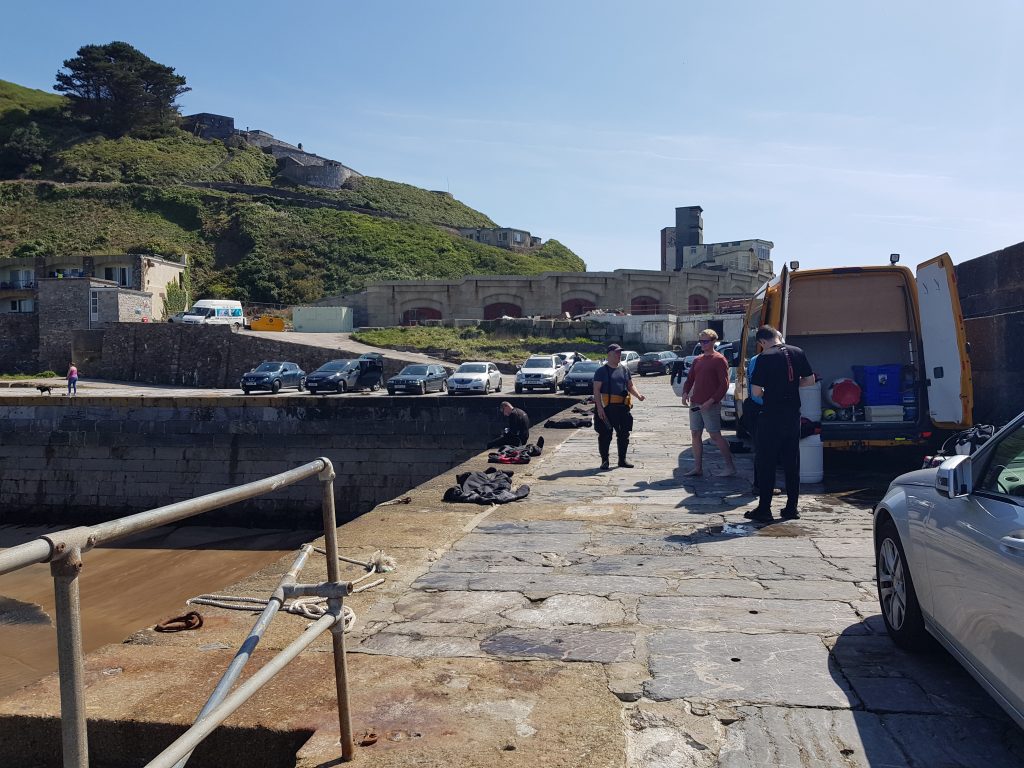 | 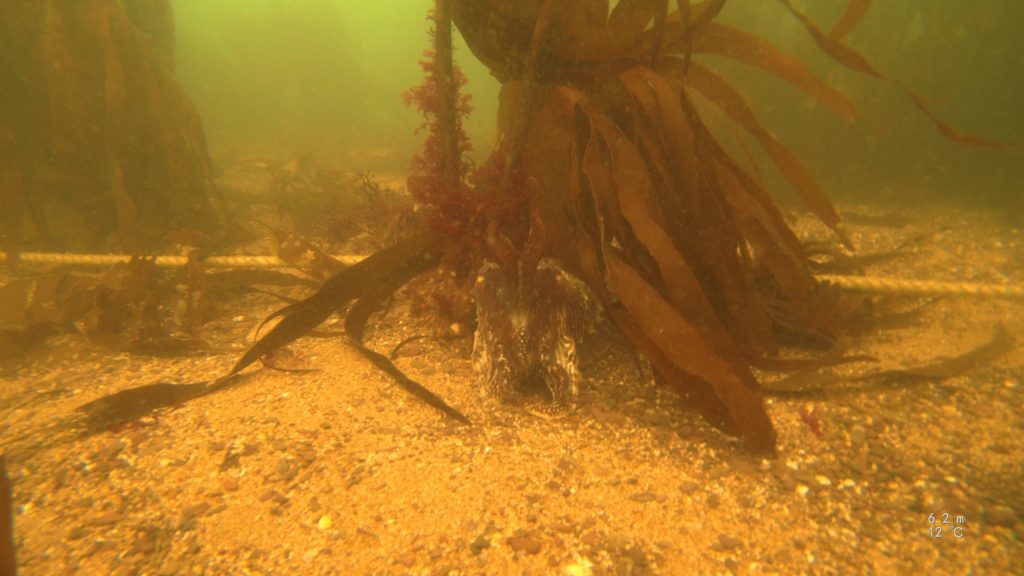 |
Fort Bovisand, Plymouth | A cuttlefish interrupts diver training! |
The next day was a real survey. Some nets had been spotted on the James Egan Layne (JEL) and we were off to find and survey them. At around 10 o’clock John Shelly from Plymouth Sound Divers, who were kind enough to provide us a with a RHIB for the day, launched it and we hauled our kit aboard. Once we were ready and with our highly competent cox, Will Schwarz, we headed out to the JEL. With mill pond ripples and warm sunshine we had a very pleasant trip to our destination only to find our lucky streak was still running as there were no other boats on the JEL, although the Scylla a short distance away had six! The shotline was dropped on the bow and once ready we split into two teams and rolled off the boat into the invitingly cool water. The plan was simple, our team was to head to the stern, find and survey the nets, while the other team was to survey the bow. Later we would compile our reports and present them to the other team. I guess we hadn’t appreciated how much of a swim it was to the stern, and we didn’t get there as we soon started to find nets tangled up in the wreckage. We took it in turns to take notes and recorded video and before we knew it, we had run out of time and were heading to the surface.
Our second wreck was the Glen Strathallan. Our team had been given a report of lost gear and it was our job to locate and survey it. We failed miserably. The survey had indicated it was south east of the boilers. We found the boilers and headed south east, but what we had failed to remember was the distance from the boilers and after ten minutes of finning we decided we were unsuccessful. We did find a lobster line and very quickly decided it was live as we could see very fresh bait. We headed back to the boilers and with a bit of direction from out instructor, Fred, we found the nets – 3 metres from the boilers, exactly where the report had put them. We did a very quick survey, but as we were nearing our minimum gas, we had to ascend to the surface.
Once we were back at base, we formed into our groups to review our notes, footage and compile our reports ready for presenting to the other team. We met in the Mount Batten Bar and once we had beer, and food ordered we presented our findings to the other team. Day three would see them recovering what we had found, and us recovering what they had found!
After a good night’s sleep, we met up at Fort Bovisand for our final days’ training. The first dive was stage handling and lift practice. A creel and weight belt had been thrown in the harbour for us to practice lifts on, so we descended in our team of three and worked together to carefully lift the objects from the seabed. One of us assessing and surveying, the second assisting and the third watching for simulated entanglement hazards that could be clipped on by an instructor at any point. After we all practiced lifting and passing the stage around we headed back to the harbour wall steps thanking our lucky stars the tide was in and it was only a short climb to the top.
Just as we finished our debrief, the awesome Will Schwarz arrived in Plymouth Sound Divers boat, Diver Two. We organised our kit, locked keys inside car, carried our kit onto the boat… oh wait… what?! What did I just do with my keys? What do I do now? What a muppet I am. Quick assessment, have I got everything for diving? Yes, okay keys in car is a problem for later… Once we had finished getting ourselves and kit on the boat, we headed out to the JEL. The wind had picked up a little and was a little overcast, but then it is bank holiday Monday, so the ride was a little bumpier than the previous day. On route to the JEL, the two teams went through their dive plans and worked out who was doing what, and what they needed to do to complete their missions given to them by the other team the previous evening. Our team’s objective was to find and recover nets from around the foremast on the bow of the JEL and from underneath the plates that sat around it.
We were the second team to enter the water and after descending the expertly placed shotline onto the bow we found our target almost immediately. After a quick survey of the surroundings, we set to work. My role was overwatch, or boss, while my buddies, Rob and Nick, were Primary and Assistant and took it in turns to cut and bag any net we found. After keeping a careful eye out for entanglement hazards, providing light where I could and watching the gas consumption of the three of us I soon realised how important this job is. The two workers were entirely focused on the net and cutting it loose and were burning through their gas a lot faster than normal. We were only at a depth of 10-12 metres, so gas was the primary concern.
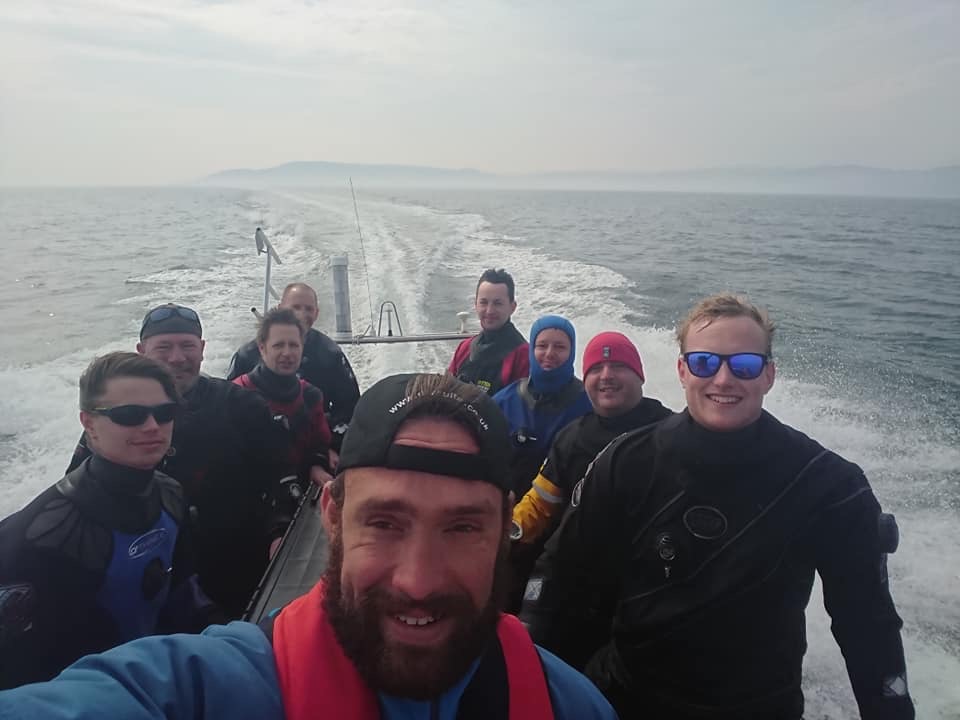 | 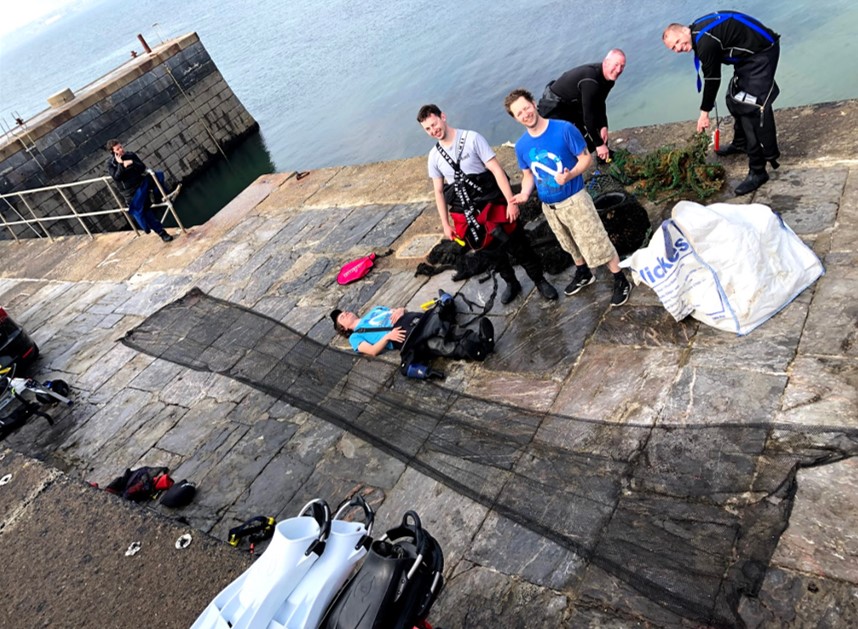 |
Dive team heading off to the James Eagan Layne | Divers survey the recovered net |
After around 45 minutes we were starting to get close to our minimum gas level, so it was time to clean up and send our bags of net to the surface. Nick expertly attached a lift bag, and as I had the stage gave a small squirt of air to start it lifting to the surface. After a steady ascent we boarded the boat and I think it is safe to say we were all buzzing, even with the car key issue in the back of my mind.
Once back in harbour, we unloaded the boat, surveyed and weighed our catch. 44 kg of net recovered!
What a great learning experience, what a great few days. I can’t wait to get on a project and recover more.
Huge thanks to Fred Nunn and John Wheeler for running the course, John Shelly for launching, and Plymouth Sound Divers for use of their RHIB. Will Schwarz for his excellent coxing, and Discovery Divers of Fort Bovisand for shore diving.
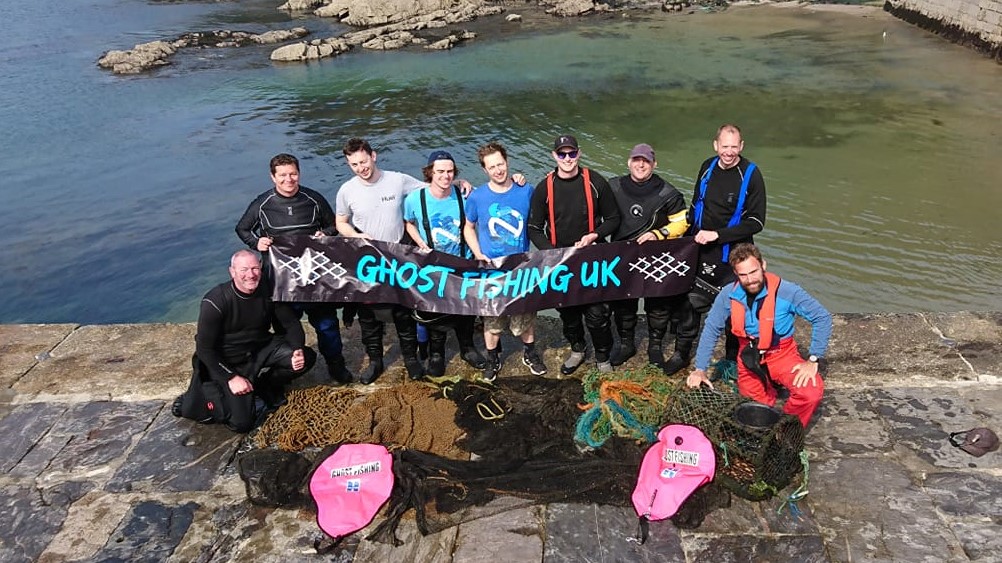 Newly minted Ghost Fishing UK divers with the instructor team. Image: Fred Nunn
Newly minted Ghost Fishing UK divers with the instructor team. Image: Fred Nunn


Comments are closed.